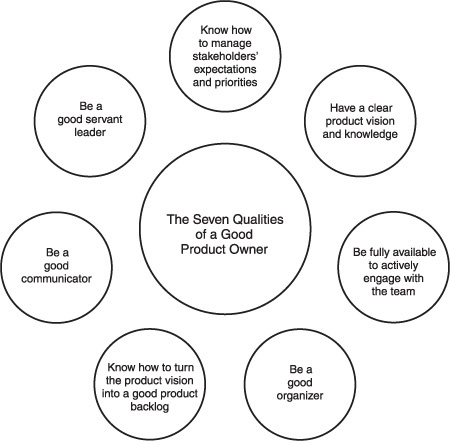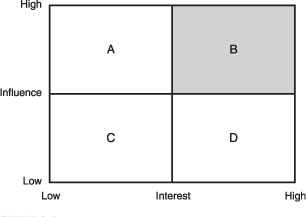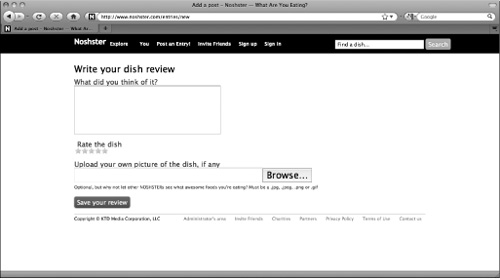Everyone is needed on an Agile project but an Agile project cannot succeed without a good product owner, who is the guardian of the product vision and goals, because the focus on an Agile or Scrum project is to deliver business results and values.
More than that, an Agile or Scrum project needs not just a good, but a great, product owner.
So the question is how can one be the best product owner possible?
We believe, based on our experience, that a product owner should possess seven key qualities. These qualities are listed in Figure 8.1.
The seven qualities of a great product owner are:
Know how to successfully manage the stakeholders’ expectations and sometimes conflicting priorities.
Have a clear vision and knowledge of the product.
Know how to gather requirements to turn the product vision into a good product backlog.
Be fully available to actively engage with the team, not only during the sprint, but also during the release and sprint planning.
Be a good organizer who can juggle multiple activities, while keeping things in perspective and maintaining her composure.
Know how to communicate the product vision; not only to the team, but also with the business, so their trust in the team remains intact throughout the life of the project.
Be a good leader, able to guide, coach, and support the team as needed while making sure that the business gets the value they expect out of IT.
Let’s now review these qualities, one by one:
One of the most important activities for the product owner is to interact with and manage stakeholders’ expectations and often conflicting priorities.
Since you may not have the time needed to spend with the stakeholders, we suggest that you learn to know and manage them differently depending on their influence on the future success of your project (Figure 8.2).
This is to say that most of your time should be spent working with the category B stakeholders who have a lot of influence and interest in your project. At the same time, you should try to get the A category to move towards the B category and, to a lesser extent, the C category to move towards the D category.
If the product owner has a clear vision about the product that will help her easily set goals and priorities, it brings a lot to the project team in its effort to create a good release and sprint plan.
Everyone has a different way to come up with a product vision, but what we use is a simple technique called the 5W, which is:
Whom? (The customer target.)
Why? (In what way is this product special?)
What? (What does the product offer?)
Where? (Location.)
When? (Time zone.)
For illustration purposes, an example would be to build a website which answers those questions in the following way as shown in Figure 8.3.
Even though having a product vision is important, maybe even more important is the product owner’s ability to come up with a good list of user stories for the product backlog.
So if you feel that you or your product owner are not skillful at gathering requirements (yet), do not hesitate to go back to Chapter 4, “A Visual Requirements Gathering for the Product Backlog” to review how to gather requirements that can easily be understood by developers and converted into tasks.
Perhaps you are lucky enough to work with a product owner who has a clear product vision and who knows how to gather requirements and backlog items.
However, that will not be enough if the product owner is not available to work and dialogue with the development team.
The product owner should be someone who is available, ideally on a daily basis, to interact with the team and attend each review meeting.
If you find yourself in a company where there is no such product owner, you should then make it a priority to explain to management that the team needs one and why the team will need to have someone who is both business savvy and empowered to interact regularly with the team and to make decisions for the business.
Unless you are lucky enough to work in a small company where the product owner has plenty of time, chances are that she is someone busy dealing with all kinds of priorities, from working with the marketing department to dealing with business issues within her own department.
If this is the case, you should be diplomatic but do not hesitate to remind the product owner that her active participation is critically necessary as part of the process.
Besides having a good product vision and the ability to write requirements that are doable and easy to understand, the best thing a product owner can do is to be an active advocate for the team with business management.
For this, he or she will need to actively work with management and users alike, always helping them to understand the team’s status relative to release goals and business value.
Finally, the product owner should be someone who knows how to be a good servant leader, someone who can guide, support, mentor, and, as needed, coach the team towards achieving the project vision and goals.
By looking at these qualities, you can ask yourself whether the product owner has all the qualities needed to be effective.
If the answer is a resounding yes, then there is nothing for you to do or to worry about.
However, if you see a gap, then it may be time for you to work with the ScrumMaster to help educate or remind the product owner of her role.
Everyone on the Scrum team has a role to play. The question is to know who can bring the most value to the business to justify the project. It should be the product owner.
The next question is how one can be the best product owner possible.
From our experience on real-life projects, the product owner should possess the seven qualities outlined in this chapter.



